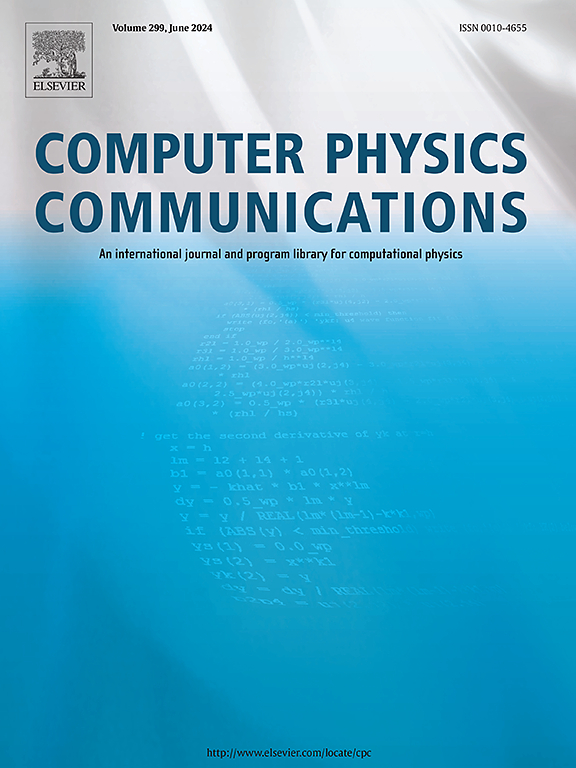Goodbye Christoffel symbols: A flexible and practical approach for solving physical problems in curved spaces
IF 7.2
2区 物理与天体物理
Q1 COMPUTER SCIENCE, INTERDISCIPLINARY APPLICATIONS
引用次数: 0
Abstract
Traditional methods for solving physical equations in curved spaces, particularly in areas like fluid dynamics and continuum mechanics, often face significant complexity due to the necessity of incorporating Christoffel symbols to account for spatial curvature. These symbols complicate the formulation and numerical implementation. In this paper, we present a novel and flexible methodology that entirely obviates the need for Christoffel symbols by fundamentally changing the approach to problem formulation and solution. The method operates by formulating the physical problem directly within a Euclidean 3D Cartesian space, where differential operators are standard and well-defined. The core of our innovation lies in the combined and systematic application of symbolic calculus to perform both the necessary chain rule transformations between the physical curved space and the embedding Euclidean space, and the subsequent projection operations. This powerful symbolic framework allows us to effectively derive and solve the governing equations on the curved geometry without explicitly computing or using Christoffel symbols or specialized curved-space operators. We demonstrate the robustness, flexibility, and advantages of this approach through several examples, including the derivation of the Navier-Stokes equations in cylindrical coordinates, the modelling of complex flows in bent cylindrical tubes, and the simulation of the breakup of viscoelastic threads. These examples highlight the method's ability to simplify the mathematical formulation and provide a robust framework for complex or evolving geometries. The flexibility in choosing basis representations within the Euclidean space is also shown to offer potential benefits for numerical stability in certain applications.
再见克里斯托费尔符号:一种解决弯曲空间物理问题的灵活实用的方法
在弯曲空间中求解物理方程的传统方法,特别是在流体力学和连续介质力学等领域,由于需要结合克里斯托费尔符号来解释空间曲率,通常面临着极大的复杂性。这些符号使公式和数值实现复杂化。在本文中,我们提出了一种新颖而灵活的方法,通过从根本上改变问题的表述和解决方法,完全避免了对克里斯托费尔符号的需要。该方法通过在欧几里德三维笛卡尔空间中直接表述物理问题来操作,其中微分算子是标准且定义良好的。我们创新的核心在于结合和系统地应用符号微积分,在物理弯曲空间和嵌入欧几里德空间之间进行必要的链式法则变换,以及随后的投影运算。这个强大的符号框架允许我们在不显式计算或使用克里斯托费尔符号或专门的弯曲空间算子的情况下有效地推导和求解弯曲几何上的控制方程。我们通过几个例子证明了这种方法的鲁棒性、灵活性和优势,包括圆柱坐标下Navier-Stokes方程的推导、弯曲圆柱管中复杂流动的建模以及粘弹性螺纹断裂的模拟。这些例子突出了该方法简化数学公式的能力,并为复杂或不断变化的几何图形提供了一个健壮的框架。在欧几里得空间中选择基表示的灵活性也显示出在某些应用中为数值稳定性提供潜在的好处。
本文章由计算机程序翻译,如有差异,请以英文原文为准。
求助全文
约1分钟内获得全文
求助全文
来源期刊

Computer Physics Communications
物理-计算机:跨学科应用
CiteScore
12.10
自引率
3.20%
发文量
287
审稿时长
5.3 months
期刊介绍:
The focus of CPC is on contemporary computational methods and techniques and their implementation, the effectiveness of which will normally be evidenced by the author(s) within the context of a substantive problem in physics. Within this setting CPC publishes two types of paper.
Computer Programs in Physics (CPiP)
These papers describe significant computer programs to be archived in the CPC Program Library which is held in the Mendeley Data repository. The submitted software must be covered by an approved open source licence. Papers and associated computer programs that address a problem of contemporary interest in physics that cannot be solved by current software are particularly encouraged.
Computational Physics Papers (CP)
These are research papers in, but are not limited to, the following themes across computational physics and related disciplines.
mathematical and numerical methods and algorithms;
computational models including those associated with the design, control and analysis of experiments; and
algebraic computation.
Each will normally include software implementation and performance details. The software implementation should, ideally, be available via GitHub, Zenodo or an institutional repository.In addition, research papers on the impact of advanced computer architecture and special purpose computers on computing in the physical sciences and software topics related to, and of importance in, the physical sciences may be considered.
 求助内容:
求助内容: 应助结果提醒方式:
应助结果提醒方式:


